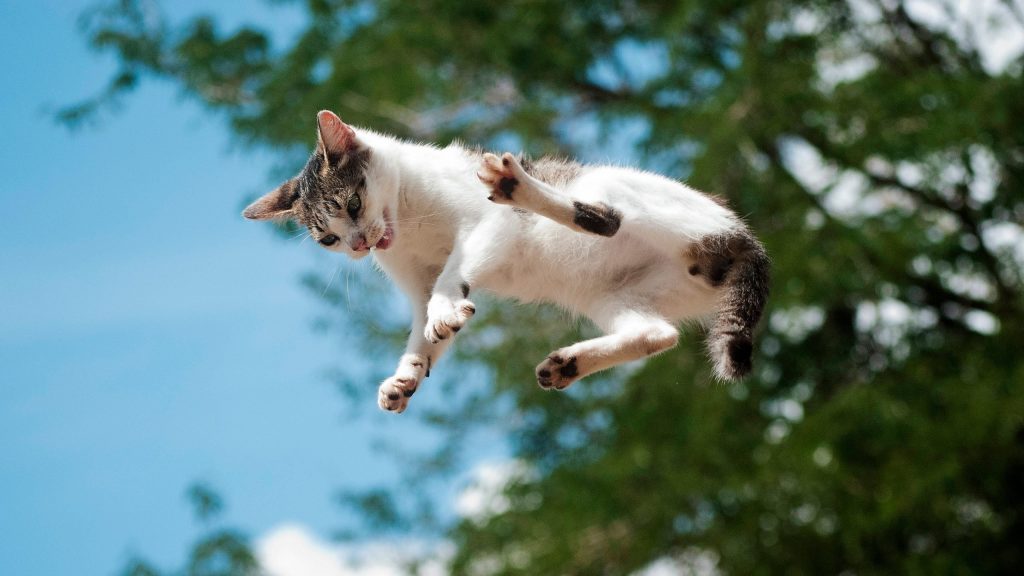
Anyone who has ever owned a cat – which is to say, has been owned by a cat – quickly comes to realize they are creatures of deep mystery.
And no mystery has been more fascinating over the centuries than the phenomenon of “cat-righting.”
How is it possible that cats always seem to land on their feet?
Whether falling from heights of six inches or six stories, felines somehow “right themselves” in mid-air – typically in less than half a second – and descend to the Earth paws-first. Firefighters have reported that when they reached out to help a terrified, tree-bound kitten100 feet above the ground, it responded to their presence with even greater trepidation. It therefore leaped to the ground below – and calmly walked away. Observers have documented cat-tumbles from window ledges on the 30th floor of high-rise apartments (cats do not appear to be gifted with the sure-footedness of mountain goats) that resulted in little more than minor bumps and bruises.
What accounts for this remarkable set of survival skills in the average cat’s toolbox?
Author, physicist, and cat lover Gregory J. Gbur recently devoted 337 pages to telling the story of how cat-righting has stumped the most brilliant minds for more than two centuries. Falling Felines and Fundamental Physics is a tour de force of the history of science – in particular, how the quest to figure out the motion of cats has helped solve riddles in mathematics, geophysics, neuroscience, and even space exploration.
The eminent physicist James Clerk Maxwell, for instance – famous for being the first to discern the interrelationship of electricity and magnetism – was also a cat-dropper. Maxwell, who along with Albert Einstein did more than anyone else to describe the nature of reality, was endlessly fascinated with the “cat flip” – a mystery he was never able to solve.
Here we should pause to point out that Maxwell the cat-thrower never harmed any felines in the course of his studies. Nor should we. Gbur asserts that while a handful of cats seem to enjoy righting themselves if we should toss them toward the couch, the vast majority are unenthusiastic about science experiments.
So, after centuries of intense study and reflection, what have scientists learned about cat-righting?
Despite cutting edge theories, techniques and stop-motion photography, significant disagreements remain. Engineers have never been able to program a robot to do what cats do without thinking. Gbur asks, “In a world where we have mastered the atom, built the internet, and sent people to the moon, how can scientists still struggle to understand and replicate the motion of a cat?”
Four main theories have emerged.
First, the Falling Figure Skater (proposed in 1850). Just as a spinning figure skater can speed up or slow down by adjusting the motion of her limbs, a cat can alter its body position by pulling in or extending its paws. Second, the Tuck and Turn (1894). A freefalling cat, by pulling in one part of its body, can accelerate the motion of the rest of its body. Third, the Propeller Tail (1895). If a cat rotates its tail in one direction, its body moves in the opposite direction. And finally, the Bend and Twist (1935, not to be confused with the Bend and Snap, Elle Woods’ tactic to impress guys in Legally Blonde). By bending at its waist, a cat can counter-rotate the two sections of its body, canceling out its angular momentum.
OK, enough.
Until there’s a major scientific breakthrough, it’s enough to say that cat-righting happens because this is simply what cats do.
Which brings us to a question that is much more likely to impact our own lives: When we are in freefall, how can we ever land on our feet?
We’re not talking about skydiving, but the metaphor of “falling” when dreadful things happen. How can we survive the humiliation of a major, self-imposed moral failure? Or the discovery that someone has betrayed us, stealing our confidence that we will ever be able to trust again? Or the hammering of the final nail into the coffin of one of our deepest dreams, which is now forever beyond our reach? Or the collapse of our hope that God is really there, or at least the kind of God who keeps his promises?
There’s no such thing as an automatically self-correcting, spin-altering, crash-averting mechanism inside human hearts and minds.
When disaster strikes, it can feel as if we’re falling into the abyss.
But we can find hope at one of the humblest addresses in the New Testament. The book of Jude boasts only one short chapter. It is rarely quoted. But it ends with a dramatic, two-verse flourish: “Now to him who is able to keep you from falling [that is, from falling in such a way that you can never recover] and to present you before his glorious presence without fault and with great joy – to the only God our Savior be glory, majesty, power, and authority, through Jesus Christ our Lord, before all ages, now and forevermore. Amen.” (Jude 24-25)
There may be days that will lead us to conclude we’re not going to make it.
But as long as we have given ourselves to Jesus, he still has places for us to go and missions for us to undertake.
Which means he’ll make sure we land on our feet.
